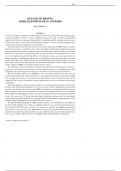Exam (elaborations)
OCEANIC HYDRATES: MORE QUESTIONS THAN ANSWERS
- Course
- Institution
From an oil industry standpoint, methane hydrate is known as a major problem because it plugs casing and pipelines. From a media standpoint, hydrates provide an almost inexhaustible supply of articles concerning greenhouse effects, landslides, global warming and mysterious events such as the ...
[Show more]



